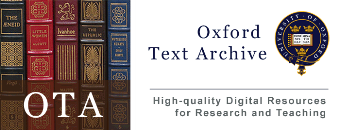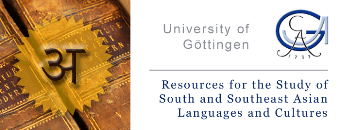![]() Introduction
Introduction
The Postgraduate Diploma in Sanskrit is a one-year programme by coursework, which is designed for those who have a basic knowledge of Sanskrit and wish to improve it. By following this programme, the students would have a sufficient training in classical Sanskrit grammar to translate texts into and from Sanskrit, and to write short essays in Sanskrit. They would also gain an advanced knowledge of Sanskrit literature from the Vedic to classical and modern periods. Further, they would improve their skills of reading, understanding, and appreciating poetical works in both prose and verse, and become familiar with the major theories of Sanskrit dramaturgy and rhetoric.
All are compulsory courses and none of the courses has prerequisites. However, depending on the student body involved, all the courses will be available in either English or Sinhala in any given academic year. All the courses carry three credits each and the independent study one credit, while an applicant should earn 25 credits to be qualified for the diploma.
Layout of Courses:
| Semester | Course Code | Course Title |
| First | SKT 501 | Sanskrit Poetry I |
| First | SKT 502 | Sanskrit Drama and Dramaturgy |
| First | SKT 503 | Sanskrit Rhetoric |
| First | SKT 504 | Sanskrit Grammar |
| Second | SKT 505 | Sanskrit Prose |
| Second | SKT 506 | Translation and Composition |
| Second | SKT 507 | Sanskrit Poetry II |
| Second | SKT 508 | History of Sanskrit Literature |
![]() Diploma Syllabus
Diploma Syllabus
Semester ONE
SKT 501 - Sanskrit Poetry I
| Course Code | SKT 501 |
| Course Title | Sanskrit Poetry I |
| Aims | This course aims to introduce to the students the poetical works written in simple Sanskrit and on diverse themes. |
| ILOs | At the end of the course, the students would be able to read, understand, and appreciate the poetical works in simple Sanskrit, and recognize the salient features of Sanskrit poetical literature. |
| Course Content | This course covers the following topics: (a) Origin and development of the poetical literature in Sanskrit; (b) Approaches to the appreciation of author, theme, style, and language, (c) Tools for the evaluation of poetical texts. Prescribed texts: Selected passages from the Mahābhārata, the Rāmāyaṇa, the Smṛti literature and modern Sanskrit literature. |
| Recommended Readings | i. තිලකසිරි, ජයදේව. 1961. සංස්කෘත
කාව්ය සාහිත්යය. කොළඹ: සීමාසහිත එක්සත් ප්රවෘත්තිපත්ර
සමාගම. ii. Dasgupta, S. N. 1962. A history of Sanskrit literature, Vol. II, Chap. I, II, III. Calcutta: University of Calcutta. iii. Lienhard, Siegfried. 1984. A History of Classical poetry: Sanskrit-Pali-Prakrit. In: A history of Indian literature, (ed.) Jan Gonda, Vol. III, Fasc. I. Wiesbaden: Otto Harrassowitz. iv. Haksar, A. N. D. 1995. Glimpses of Sanskrit literature. New Delhi: Indian Council for Cultural Relations & New Age International. v. Keith, Arthur Berriedale. 2007. A history of Sanskrit literature. Oxford: The Clarendon Press. First published in 1928. |
SKT 502 - Sanskrit Drama and Dramaturgy
| Course Code | SKT 502 |
| Course Title | Sanskrit Drama and Dramaturgy |
| Aims | The aim of this course is to introduce to the students the theories of Sanskrit dramaturgy as expounded by Bharatamuni and his followers. It also aims to familiarize the students with the Sanskrit dramas of well-known writers in the classical period. |
| ILOs | On successful completion of the course, the students will be able to describe substantially the theories of Sanskrit dramaturgy and identify peculiar features of major Sanskrit dramatists and their works. |
| Course Content | This course covers the following
topics: (a) Origin and development of Sanskrit dramatic
literature, (b) Various theoretical aspects of drama
and its performance as explained in the Nāṭyaśāstra
and the Daśarūpaka, (c) evaluation and
appreciation of selected acts from Sanskrit dramas. Prescribed Texts: Selected acts from the Svapnavāsavadattā of Bhāsa and the Abhijñānaśakuntalā of Kālidāsa. |
| Recommended Readings | i. තිලකසිරි, ජයදේව. 1971. සංස්කෘත
නාට්ය සාහිත්යය. කොළඹ: සීමාසහිත ලේක්හවුස් ඉන්වෙස්ට්මන්ට්.
ii. Bhat, G.K. 1985. Sanskrit Drama: Problems and Perspectives. Delhi: Aganta. iii. Kāle, M. R. 1982. Svapnavāsavadattā of Bhāsa. Delhi: Motilal Banarsidass. iv. Kāle, M. R. 1990. The Abhijñānaśakuntalā of Kālidāsa. Delhi: Motilal Banarsidass. v. Keith, Arthur Berriedale. 1998. The Sanskrit drama in its origin, development, theory, and practice. Oxford: The Clarendon Press. First published in 1924. |
SKT 503 - Sanskrit Rhetoric
| Course Code | SKT 503 |
| Course Title | Sanskrit Rhetoric |
| Aims | This course introduces to the students the theories of Sanskrit rhetoric that are applicable to composing works in verse (padya), prose (gadya), and verse-cum-prose (campū). |
| ILOs | At the end of the course, the students will be able to describe major theories of Sanskrit rhetoric and apply them to appreciation of poetry. |
| Course Content | This course covers the following topics: (a) History of Sanskrit rhetoric, (b) Classification of literary compositions, (c) Problems in Sanskrit Poetics, (d) Principles of Literary Criticism, (e) Eight major Theories of Sanskrit Rhetoric: (i) Rasavāda, (ii) Guṇavāda, (iii) Alaṅkāravāda, (iv) Rītivāda, (v) Vakroktivāda, (vi) Aucityavāda, (vii) Anumitivāda, and (viii) Dhvanivāda. Prescribed Texts: Selected sections from the Dhvanyāloka and the Kavyādarśa. |
| Recommended Readings | i. පේමරතන හිමි, වැලිවිටියේ සහ
දේවානන්ද හිමි, හල්ගස්තොට (පරි.). 1951. කාව්යාදර්ශ
(සිංහල පරිවර්තනය). කොළඹ: එස්. ගොඩගේ සහ සමාගම. ii. සේනානායක, ජී. එස්. බී. 1969. ධ්වන්යාලෝක විවරණය. කොළඹ: සීමාසහිත ඇම්. ඞී. ගුණසේන සහ සමාගම. iii. විජයවර්ධන, හේමපාල. 1967. සංස්කෘත කාව්ය විචාරයේ මූලධර්ම. කොළඹ: සීමාසහිත ඇම්. ඞී. ගුණසේන සහ සමාගම. iv. Gerow, Edwin. 1977. Indian Poetics, A History of Indian Literature, (ed. Jan Gonda) Volume V, Facs. 3. Wiesbaden: Otto Harrassowitz. v. De, S. K. 1960. History of Sanskrit Poetics. Calcutta: Firma K. L. Mukhopadhyay. vi. Kane, P. V. 1994. History of Sanskrit Poetics. Delhi: Motilal Banarsidass. |
SKT 504 - Sanskrit Grammar
| Course Code | SKT 504 |
| Course Title | Sanskrit Grammar |
| Aims | This course aims to introduce to the students the laws and rules that govern classical Sanskrit Language and to improve their command of it. |
| ILOs | At the end of the course, the students will be able to identify grammatical features in Classical Sanskrit literature and use them in translating non-technical texts from and into Sanskrit. |
| Course Content | This course covers the following topics: (a) Euphonic combinations (sandhi), compounds (samāsa), tenses and moods; (b) Declension of nouns and conjugation of verbs; (c) Infinitive (tumanta), Causative (ṇijanta), Desiderative (sannanta), Intensive (yaṅanta), and Denominative (nāmadhātu) forms of verb, (d) Commonly found sentence structures; (e) Grammatical issues related to translating texts from and into Sanskrit. |
| Recommended Readings | i. ජයසූරිය, එම්. එච්. එෆ්. 1961.
සංස්කෘත ශික්ෂකය, ප්රථම පුස්තකය. රාජ්ය භාෂා දෙපාර්තමේන්තුව,
කොළඹ. ii. ජයසූරිය, එම්. එච්. එෆ්. 1971. සංස්කෘත ශික්ෂකය, ද්විතීය පුස්තකය. කොළඹ: රාජ්ය භාෂා දෙපාර්තමේන්තුව. iii. කුටුම්බශාස්ත්රී, වෙම්පති. 2004. සංස්කෘත ස්වාධ්යායඃ, (සංස්කෘතභාරතී ප්රථමා දීක්ෂා, ද්විතීයා දීක්ෂා). නවදිල්ලි: රාෂ්ටී්රය සංස්කෘත සංස්ථානම්. iv. Egenes, Thomas. 1996. Introduction to Sanskrit. Part I, II. Delhi: Motilal Banarsidass. v. Egenes, Thomas. 1990. Sanskrit workbook: learning the alphabet. Fairfield, Iowa: Maharishi International University Press. |
Semester TWO
SKT 505 - Sanskrit Prose
| Course Code | SKT 505 |
| Course Title | Sanskrit Prose |
| Aims | This course aims to introduce to the students the prose literature in Sanskrit and the major authors of it. |
| ILOs | Upon the successful completion of the course, the students will be able to describe the distinctive features of the Sanskrit prose literature and appreciate prose compositions by renowned Sanskrit authors. |
| Course Content | This course covers the following topics: (a) Origin and development of the Sanskrit prose literature; (b) Literary merits of the works by Daṇḍin, Bāṇabhaṭṭa, and Subandhu; (c) Decline of prose literature; (d) Modern prose literature in Sanskrit. Prescribed Texts: Selections from the Daśakumāracarita, the Kādambarī, the Vāsavadattā, and modern Sanskrit prose literature. |
| Recommended Readings | i. Macdonell, A. A. 1962. A history
of Sanskrit literature, Chap. II - VIII. Delhi:
Motilal Banarsidass. ii. Gupta, Dharmendra Kumar. 1970. Critical study of Dandin and his works, Delhi: Meharchand Lachhman Dass. iii. Hueckstedt, Robert A. 1985. The style of Bāna: an introduction to Sanskrit prose poetry. Lanham: University Press of America. iv. Layne, Gwendolyn 1989. Kādambarī: a classic Sanskrit story of magical transformations. New York: Garland Publishers. v. Paṇḍā, Ravīndra Kumāra. 2011. Sanskrit prose literature of modern period. Vadodara, Gujarat: Arvachina Sanskrit Sahitya Parishad. |
SKT 506 - Translation and Composition
| Course Code | SKT 506 |
| Course Title | Translation and Composition |
| Aims | This course aims to introduce to the students the theories and practices of translating texts from and into Sanskrit and to composing texts in Sanskrit. |
| ILOs | At the end of the course, the students will be able to identify different translation theories and practices pertinent to Sanskrit and write short essays in Sanskrit on a given topic using them. |
| Course Content | This course covers the following topics: (a) Syntactical, grammatical, and vocabulary issues in translating, (b) Tools for translating simple prose passages, stories, reports, letters, and verses; (c) Communication in Sanskrit in day-to-day life, (d) Rules and practices in composing in Sanskrit, (e) Common structures followed in Sanskrit compositions. |
| Recommended Readings | i. Set of VCDs produced by the
Saṃskṛta Bharati, Bangalore: Saṃskṛta Bharati. ii. Apte, V. S. 1913. The student’s guide to Sanskrit composition. Bombay: The Oriental Publishing Company. iii. Apte, V. S. 1915. A key to Apte’s Guide to Sanskrit composition. Bombay: The Oriental Publishing Company. iv. Pollock, Sheldon I. 1977. Aspects of versification in Sanskrit lyric poetry. New Haven, Conn: American Oriental Society. v. Mishra, Madhusudan. 2006. An introduction to Sanskrit: Sanskrit grammar and composition. Delhi: Parimal Publications. |
SKT 507 - Sanskrit Poetry II
| Course Code | SKT 507 |
| Course Title | Sanskrit Poetry II |
| Aims | This course aims to introduce to the students the prose literature in Sanskrit and the major authors of it. |
| ILOs | At the end of the course, the students will be able to read, understand, and appreciate the poetical works in advanced Sanskrit analyze the phases of development of the poetical literature. |
| Course Content | This course covers the following topics: (a) Special tendencies of the Sanskrit poetical literature; (b) Approaches to the appreciation of poetical works in the light of figures of speech (Sanskrit verses on different themes from Mahākavyas, Laghukāvyas, and Śatakas are selected for discussion). Prescribed Texts: Selections from the Uttaramegha of the Meghadūta, the Raghuvaṃśa, the Kumārasambhava, the Buddhacarita, and the Vairāgyaśataka. |
| Recommended Readings | i. තිලකසිරි, ජයදේව. 1961. සංස්කෘත
කාව්ය සාහිත්යය. කොළඹ: සීමාසහිත එක්සත් ප්රවෘත්තිපත්ර
සමාගම. ii. Lienhard, Siegfried. 1984. A History of Classical poetry: Sanskrit-Pali-Prakrit. A history of Indian literature (ed.) Jan Gonda, Vol. III, Fasc. I. Wiesbaden: Otto Harrassowitz. iii. Dasgupta, S. N. 1962. A history of Sanskrit literature, Vol. II, Chap. I, II, III. Calcutta: University of Calcutta. iv. Haksar, A. N. D. 1995. Glimpses of Sanskrit literature. New Delhi: Indian Council for Cultural Relations & New Age International. v. Keith, Arthur Berriedale. 2007. A history of Sanskrit literature. Oxford: The Clarendon Press. First published in 1928. |
SKT 508 - History of Sanskrit Literature
| Course Code | SKT 508 |
| Course Title | History of Sanskrit Literature |
| Aims | This course aims to provide the students with a broad picture of the Vedic and classical literature up to the modern period. |
| ILOs | Upon the completion of this course, the students will be able to identify the prominent features of the Vedic and classical literature up to the modern period, in terms of well-known authors, literary genres, and major trends. |
| Course Content | This course covers the following topics: (a) Introduction to Vedic language and classical Sanskrit, (b) Śruti and Smṛti categories of literature, (c) Contents of the Triveda, Caturveda, and Pañcamaveda, (d) Problems of chronology in Sanskrit literature, (e) Determiners of the chronology of poets, works, and trends, (f) Secularization and diversification of subject matter/ theme, (g) Decline of Sanskrit dominance, (h) Renaissance of modern Sanskrit studies, (i) Sanskrit in the contemporary literary genres. |
| Recommended Readings | i. Bhattacharji, Sukumari. 1984-6.
Literature in the Vedic Age. Vol. 1. The Samhitās,
Vol. 2, The Brāhmanas, Āranyakas, Upanisads and
Vedānga Sūtras. Calcutta: K. P. Bagchi & Company. ii. Gonda, Jan. 1975. Vedic literature. A history of Indian literature. Wiesbaden: Otto Harrassowitz. iii. Lienhard, Siegfried. 1984. A History of Classical poetry: Sanskrit-Pali-Prakrit. A history of Indian literature (ed.) Jan Gonda, Vol. III, Fasc. I. Wiesbaden: Otto Harrassowitz. iv. Haksar, A. N. D. 1995. Glimpses of Sanskrit literature. New Delhi: Indian Council for Cultural Relations & New Age International. v. Keith, Arthur Berriedale. 2007. A history of Sanskrit literature. Oxford: The Clarendon Press. First published in 1928. |









